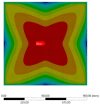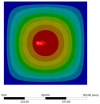Finite Element Analysis of Steel Plates with Rectangular Openings Subjected to Axial Stress
- PMID: 35806545
- PMCID: PMC9267429
- DOI: 10.3390/ma15134421
Finite Element Analysis of Steel Plates with Rectangular Openings Subjected to Axial Stress
Abstract
Steel plates with openings are among the important ship structural components used in the ship's hull to withstand the hydrostatic forces of the ocean, which cause sagging and hogging moments at the ship's bottom. The existence of openings on plates can cause structural rupture, stress concentration and a decrease in ultimate strength. This research is aimed at investigating the influence of selected parameters on the ultimate capacity of steel plates with rectangular holes subjected to axial stress, using ANSYS finite element analysis (FEA) under its non-linear static structural programme. The main parameters investigated in this paper are the plate thickness, opening aspect ratio, number of openings, position of openings, and the boundary condition of the plate. The influence of these parameters on the stress of plates and their deformation was evaluated. The comparison of the numerical simulation with the well-established analytical method using the Navier solution and Roark's Formulas showed a good agreement.
Keywords: finite element analysis; rectangular openings; steel plates; stress analysis.
Conflict of interest statement
The authors declare no conflict of interest, and the funders had no role in the design of the study; in the collection, analyses, or interpretation of data; in the writing of the manuscript; or in the decision to publish the results.
Figures


























References
-
- Doan V.T., Liu B., Garbatov Y., Wu W., Guedes Soares C. Strength assessment of aluminium and steel stiffened panels with openings on longitudinal girders. Ocean. Eng. 2020;200:107047. doi: 10.1016/j.oceaneng.2020.107047. - DOI
-
- Yao T., Fujikubo M. Buckling and Ultimate Strength of Ship and Ship-Like Floating Structures. Butterworth-Heinemann; Oxford, UK: 2016.
-
- Laursen W. IACS Acts on MOL Comfort Report. 2015. [(accessed on 21 May 2022)]. Available online: https://www.maritime-executive.com/article/iacs-acts-on-mol-comfort-report.
-
- Paik J.K., Thayamballi A.K., Pedersen P.T., Park Y.I. Ultimate strength of ship hulls under torsion. Ocean Eng. 2001;28:1097–1133. doi: 10.1016/S0029-8018(01)00015-4. - DOI
-
- Molland A.F. The Maritime Engineering Reference Book: A Guide to Ship Design, Construction and Operation. Elsevier; Amsterdam, The Netherlands: 2011.
LinkOut - more resources
Full Text Sources

